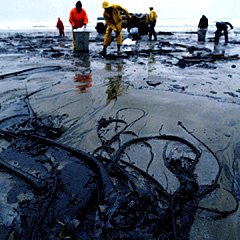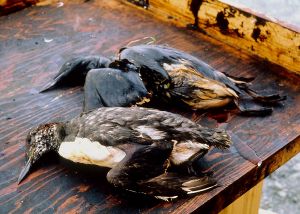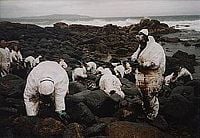Oil Spill
 From Nwe
From Nwe 
An oil spill is the unintentional release of a liquid petroleum hydrocarbon into the environment as a result of human activity. Oil can refer to many different materials, including crude oil, refined petroleum products (such as gasoline or diesel fuel) or by-products, ships' bunkers, oily refuse, or oil mixed in waste. Most man-made oil pollution comes from land-based activity, but the term often refers to the release of oil into the ocean or coastal waters. Public attention and subsequent regulation has tended to focus mainly on seagoing oil tankers.[1]
Petroleum-based hydrocarbons can negatively impact marine life and seabirds even at low concentrations. Oil that is denser than water settles on and penetrates the seabed, and it may take months or even years to clean up. Some methods to clean up an oil spill include the use of bioremediation, dispersants, dredging, and skimming.
It should be noted that oil is also released into the environment from natural geologic seeps on the sea floor.[2]
Environmental effects

The lighter fractions of oil, such as benzene and toluene, are highly toxic, but they are also volatile and evaporate quickly. Heavier components of crude oil, such as polynuclear aromatic hydrocarbons (PAHs) appear to cause the most damage. Although they are less toxic than the lighter volatiles, they persist in the environment much longer.
A heavy oil spill can also blanket estuaries and shoreline ecosystems, such as salt marshes and tidal pools, preventing gas exchange and blocking light. The oil can mix deeply into pebble, shingle, or sandy beaches, where it may remain for months or even years.
Seabirds are severely affected by spills, as the oil penetrates and opens up the structure of their plumage, reducing the insulating ability of their feathers, making the birds more vulnerable to temperature fluctuations and much less buoyant in the water. The oiled feathers also impairs the birds' ability to fly, making it difficult or impossible to forage and escape from predators. As they attempt to preen, birds typically ingest oil that coats their feathers, causing kidney damage, altered liver function, and digestive tract irritation. The limited foraging ability coupled with the ingestion of oil quickly leads to dehydration and metabolic imbalances. Most birds affected by an oil spill die in the absence of supportive human intervention.
Marine mammals exposed to oil spills are affected in many of the same ways as seabirds. Oil coats the fur of sea otters and seals, reducing the natural insulation ability of their fur, leading to body temperature fluctuations and hypothermia. Ingestion of the oil also causes dehydration, and impaired digestion.
Cleaning up an oil spill
Some equipment used for cleanup:
- Absorbent Boom, Sausage
- Containment Boom (except for gasoline where confinement can cause dangerous levels of fume buildup)
- Skimmers
- Snares
Some methods used for cleanup:
- Bioremediation: use of biological agents to remove oil.[3]
- Burning: It can be done only when it is not windy, the oil has not dispersed, and the sea is calm.
- Dispersants: Dispersants act as detergents, clustering around oil globules and allowing it to be carried away in the water.[4] While this makes the surface look pretty, it only spreads the oil around. This could be a benefit since smaller oil droplets, scattered with currents, may cause less harm and may be easier to degrade. However, the dispersed oil droplets readily sink and can lethally contaminate coral. Moreover, recent research indicates that dispersants themselves are toxic to corals.[5]
- Do nothing: Some have advocated doing nothing and letting the oil evaporate or break down on its own, rather than making matters worse by attempting to clean up. As noted above, cleanup by detergents pollutes the seabed. Also, shoreline cleanup can further disturb the ecology by bleaching all life from the area.
- Dredging: This method is used for oils dispersed with detergents and other oils denser than water.
- Skimming: This approach can't be used if the sea is rough.
- Solidifying the material.
Spill Prevention
- Secondary Containment: This includes methods to prevent releases of oil or hydrocarbons into the environment.
- SPCC: Oil Spill Prevention Containment and Countermeasures program by U.S. Environmental Protection Agency (EPA).
- Double hulling: Building and using double hull vessels and converting single hull vessels into double hull. A double hull reduces the risk and severity of a spill in case of a collision or grounding.
Estimating the volume of a spill
|
|||
| Air pollution | |||
| Acid rain • Air Pollution Index • Air Quality Index • Atmospheric dispersion modeling • Chlorofluorocarbon • Global dimming • Global warming • Haze • Indoor air quality • Ozone depletion • Particulate • Smog • Roadway air dispersion | |||
| Water pollution | |||
| Eutrophication • Hypoxia • Marine pollution • Ocean acidification • Oil spill • Ship pollution • Surface runoff • Thermal pollution • Wastewater • Waterborne diseases • Water quality • Water stagnation | |||
| Soil contamination | |||
| Bioremediation • Herbicide • Pesticide •Soil Guideline Values (SGVs) | |||
| Radioactive contamination | |||
| Actinides in the environment • Environmental radioactivity • Fission product • Nuclear fallout • Plutonium in the environment • Radiation poisoning • radium in the environment • Uranium in the environment | |||
| Other types of pollution | |||
| Invasive species • Light pollution • Noise pollution • Radio spectrum pollution • Visual pollution | |||
| Government acts | |||
| Clean Air Act • Clean Water Act • Kyoto Protocol • Water Pollution Control Act • Environmental Protection Act 1990 | |||
| Major organizations | |||
| DEFRA • Environmental Protection Agency • Global Atmosphere Watch • Greenpeace • National Ambient Air Quality Standards | |||
| Related topics | |||
| Natural environment |
For an oil spill on water, one can calculate the total volume of oil by measuring the surface area of the spill and the average thickness of the film.[6]
| Film Thickness | Quantity Spread | |||
|---|---|---|---|---|
| Appearance | in | mm | gal/sq mi | L/ha |
| Barely visible | 0.0000015 | 0.0000381 | 25 | 0.365 |
| Silvery sheen | 0.0000030 | 0.0000762 | 50 | 0.731 |
| First trace of color | 0.0000060 | 0.0001524 | 100 | 1.461 |
| Bright bands of color | 0.0000120 | 0.0003048 | 200 | 2.922 |
| Colors begin to dull | 0.0000400 | 0.0010160 | 666 | 9.731 |
| Colors are much darker | 0.0000800 | 0.0020320 | 1332 | 19.463 |
Largest oil spills

| Spill / Tanker | Location | Date | *Tonnes of crude oil | Reference |
|---|---|---|---|---|
| Gulf War oil spill | Persian Gulf | January 23, 1991 | 136,000 - 1,500,000 | [7][8] |
| Ixtoc I oil well | Gulf of Mexico | June 3, 1979 - March 23, 1980 | 454,000 - 480,000 | [9] |
| Atlantic Empress / Aegean Captain | Trinidad and Tobago | July 19, 1979 | 287,000 | [10][11] |
| Fergana Valley | Uzbekistan | March 2, 1992 | 285,000 | [8] |
| Nowruz oil field | Persian Gulf | February 1983 | 260,000 | [12] |
| ABT Summer | 700 nautical miles (1,300 km) off Angola | 1991 | 260,000 | [10] |
| Castillo de Bellver | Saldanha Bay, South Africa | August 6, 1983 | 252,000 | [10] |
| Amoco Cadiz | Brittany, France | March 16, 1978 | 223,000 | [10][8] |
| Amoco Haven tanker disaster | Mediterranean Sea near Genoa, Italy | 1991 | 144,000 | [10] |
| Odyssey | 700 nautical miles (1,300 km) off Nova Scotia, Canada | 1988 | 132,000 | [10] |
| Sea Star | Gulf of Oman | December 19, 1972 | 115,000 | [10][8] |
| Torrey Canyon | Scilly Isles, UK | March 18, 1967 | 80,000 - 119,000 | [10][8] |
| Irenes Serenade | Navarino Bay, Greece | 1980 | 100,000 | [10] |
| Urquiola | A Coruña, Spain | May 12, 1976 | 100,000 | [10] |
One metric ton of crude oil is roughly equal to 308 US gallons, or 7.33 barrels.
See also
- Hydrocarbon
- Oil
- Petroleum
- Pollution
Notes
- ↑ Petroleum: Oil Spill Portable Planetariums. Retrieved March 12, 2008.
- ↑ Welcome to the UCSB Hydrocarbon Seeps web site UCSB Hydrocarbon Seeps Project. Retrieved March 12, 2008.
- ↑ Oil Program US EPA. Retrieved March 12, 2008.
- ↑ Detergent and Oil Spills NEWTON BBS. Retrieved March 12, 2008.
- ↑ Carolyn Barry, 2007, Slick Death: Oil-spill treatment kills coral, Science News 172:67. Retrieved March 12, 2008.
- ↑ Tchobanoglous, George, Franklin L. Burton, and H. David Stensel, Wastewater Engineering Treatment and Reuse (McGraw-Hill Series in Civil and Environmental Engineering. Boston: McGraw-Hill, 2003, ISBN 0070418780).
- ↑ Draffan, George. Major Oil Spills Endgame. Retrieved March 12, 2008.
- ↑ 8.0 8.1 8.2 8.3 8.4 History The Mariner Group. Retrieved March 12, 2008.
- ↑ John S. Patton, Mark W. Rigler, Paul D. Boehm & David L. Fiest, 1981, Ixtoc 1 oil spill: flaking of surface mousse in the Gulf of Mexico. NPG (Nature Publishing Group). Retrieved March 12, 2008.
- ↑ 10.0 10.1 10.2 10.3 10.4 10.5 10.6 10.7 10.8 10.9 Statistics ITOPF. Retrieved March 12, 2008.
- ↑ Atlantic Empress/Aegean Captain Cedre. Retrieved March 12, 2008.
- ↑ Oil Spills and Disasters infoplease. Retrieved March 12, 2008.
References
ISBN links support NWE through referral fees
- Fingas, Mervin F., and Jennifer Charles. 2001. The Basics of Oil Spill Cleanup. Boca Raton, Fla: Lewis Publishers. ISBN 1566705371
- Nelson-Smith, A. 1973. Oil Pollution and Marine Ecology. London, UK: Elek Scientific. ISBN 0236154117
- Park, Ken (ed.). 2004. The World Almanac and Book of Facts. New York, NY: World Almanac. ISBN 0886879116
- Reis, John C. 1996. Environmental Control in Petroleum Engineering. Houston, TX: Gulf Publ. ISBN 0884152731
- Tchobanoglous, George, Franklin L. Burton, and H. David Stensel. 2003. Wastewater Engineering Treatment and Reuse. McGraw-Hill Series in Civil and Environmental Engineering. Boston: McGraw-Hill. ISBN 0070418780
- Oil Spill Case Histories 1967-1991 NOAA/Hazardous Materials and Response Division. Retrieved March 12, 2008.
External links
All links retrieved November 17, 2022.
- www.cedre.fr Centre of Documentation, Research and Experimentation on Accidental Water Pollution
- International Tanker Owners Pollution Federation
Credits
New World Encyclopedia writers and editors rewrote and completed the Wikipedia article in accordance with New World Encyclopedia standards. This article abides by terms of the Creative Commons CC-by-sa 3.0 License (CC-by-sa), which may be used and disseminated with proper attribution. Credit is due under the terms of this license that can reference both the New World Encyclopedia contributors and the selfless volunteer contributors of the Wikimedia Foundation. To cite this article click here for a list of acceptable citing formats.The history of earlier contributions by wikipedians is accessible to researchers here:
- Oil spill history
The history of this article since it was imported to New World Encyclopedia:
- History of "Oil spill"
Note: Some restrictions may apply to use of individual images which are separately licensed.
↧ Download as ZWI file | Last modified: 02/04/2023 00:27:01 | 60 views
☰ Source: https://www.newworldencyclopedia.org/entry/Oil_spill | License: CC BY-SA 3.0
 ZWI signed:
ZWI signed: KSF
KSF